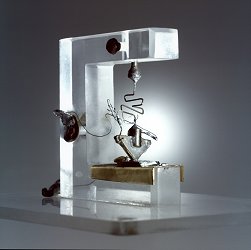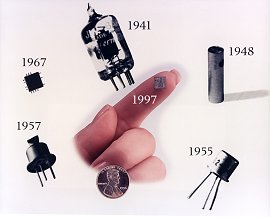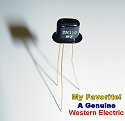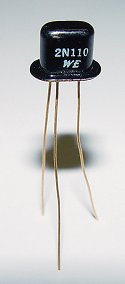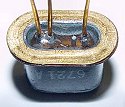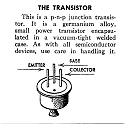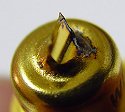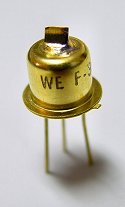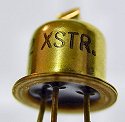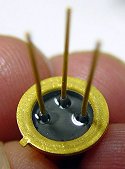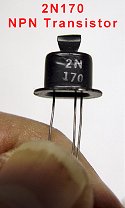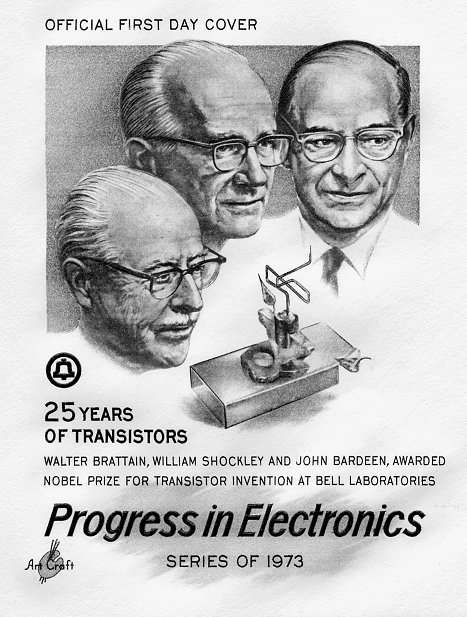“Nature abhors the vacuum tube.”- J.R. Pierce, Bell Labs engineer who coined the term ’transistor'
Click to enlarge
From the Bell Labs website:
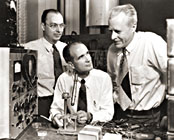
Bell Labs is the birthplace of the Transistor, inventing the device that led to a communications revolution.
John Bardeen, Walter Brattain and William Shockley discovered the transistor effect and developed the first device in December 1947, while the three were members of the technical staff at Bell Laboratories in Murray Hill, NJ. [To view the patent, see US Patent #02569347 which was issued on September 25, 1951] They were awarded the Nobel Prize in physics in 1956.
Developed as a replacement for bulky and inefficient vacuum tubes and mechanical relays, the transistor later revolutionized the entire electronics world. The transistor sparked a new era of modern technical accomplishments from manned space flight and computers to portable radios and stereos. Today, billions of transistors are manufactured weekly."
Here are a few pages from Walter Brattain’s lab notebooks on December 24th 1947, the day the world’s first transistor was successfully tested. The Bell Labs Press Release of the transistor dated July I, 1948 can be viewed by clicking HERE.
A ballot was sent around Bell Labs to come up with a name for the transistor. HERE is a (poor) copy of that ballot.
And how many of you know about the Transistor Water Tower at Bell Labs? Click HERE to find out.

We Offer Personalized One-On-One Service!
Call Us Today at (651) 787-DIAL (3425)


Source: Bell Labs
Click image above to enlarge
" A picture of the first transistor ever assembled, invented in Bell Labs in 1947. It was called a point contact transistor because amplification or transistor action occurred when two pointed metal contacts were pressed onto the surface of the semiconductor material. The contacts, which are supported by a wedge shaped piece of insulating material, are placed extremely close together so that they are separated by only a few thousandths of an inch. The contacts are made of gold and the semiconductor is germanium. The semiconductor rests on a metal base.
Source: Bell Labs
Click image above to enlarge
The shape of the transistor has changed dramatically since it was invented at Bell Labs in 1947 as a replacement for the vacuum tube. Clockwise from the top: 1941 vacuum tube used for telephone communications; the point-contact transistor as it was introduced June 30,1948 to the world, six months after its invention; 1955 transistor which replaced vacuum tubes in network communications equipment; 1957 diffused base high frequency broadband amplifier; 1967 microchip, used to produce the tones in a touch-tone telephone set, contained two transistors; and (center) a Lucent Technologies digital signal processor chip, which can contain as many as 5 million transistors, used in modems and cellular communications.
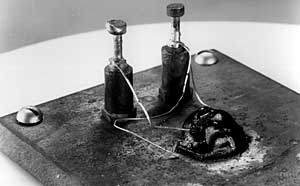
Bell Laboratories’ germanium junction transistor was fabricated in 1950
A PDF file containing images of the pages in actual lab notebook used during the invention of the transistor can be viewed HERE.

Major Milestones in Transistor Electronics
from Bell Laboratories Record magazine - January 1975, p.74
1948 - POINT CONTACT TRANSISTOR
1950 - SINGLE-CRYSTAL GERMANIUM
1951 - GROWN JUNCTION TRANSISTOR
1952 - ALLOY JUNCTION TRANSISTOR
1952 - ZONE MELTING AND REFINING
1952 - SINGLE-CRYSTAL SILICON
1955 - DIFFUSED -BASE TRANSISTORS
1957 - OXIDE MASKING
1960 - PLANAR TRANSISTOR
1960 - MOS TRANSISTOR
1960 - EPITAXIAL TRANSISTOR
1961 - INTEGRATED CIRCUITS
Gordon Teal at Texas Instruments (TI) directed the development of the silicon transistor. Texas Instruments' silicon device with its three long leads became famous making TI the sole supplier of silicon transistors for several years in the 1950’s. Morris Tanenbaum at Bell Labs actually made the first silicon transistor, but he felt “it didn’t look attractive” from a manufacturing point of view.
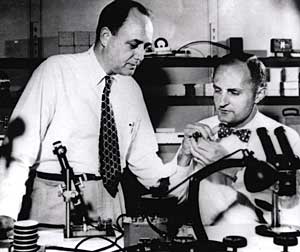
AT&T ARCHIVES
SILICON PRECURSOR: Gordon Teal [left], while working at Bell Labs, and fellow physical chemist Morgan Sparks successfully fabricated the first working junction transistor from a germanium crystal.

AT&T Archives- The Transistor, an official Bell Telephone Laboratories film on the invention of the transistor, called " The ** **Transistor".

PBS recently had a great documentary on the transistor invention called " Transistorized!". I bought the video tape of the show and highly recommend it.

“Birthplace of the Transistor” - Bell Labs 1953 advertisement of the invention of the transistor. (Scan courtesy of Mark Bearden)

Raytheon Advertisement for the CK722 and CK721 transistors in the February 1953 issue of Radio and Television News magazine.

Bell Laboratories Record - 50 years of Transistors
Bell Labs: More than 50 years of the Transistor - This document was available at one time on the Bell Labs website but has since disappeared. It is, however, preserved as an archive on this web server.

The transistor: 75 years since the famed Nokia Bell Labs invention changed the world
Bell Labs: The transistor: 75 years since the famed Nokia Bell Labs invention changed the world -

Who Really Invented The Transistor?
Some historians say that Bell Labs should not get all of the credit. To read an article on others that contributed to this invention, click**HERE.**

My Collection of Vintage Transistors
I’ve collected dozens of transistors since I was a teenager. Other kids my age were collecting record albums but transistors take up a lot less room than record albums!
The first photo is my most recent acquisition of a rare transistor which is the Western Electric point-contact part number 2N23. I actually have three of these - two are still sealed in their foil envelopes inside a cardboard container.
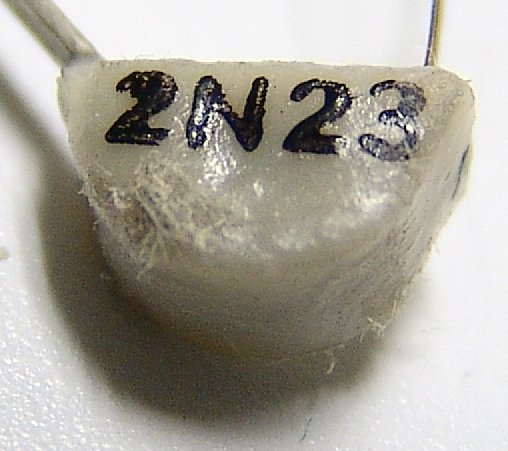
Close-up photo of top of 2N23 transistor made by Western Electric in 1954
Click on the following links to view more photos of this rare 2N23 transistor:
There is an excellent semiconductor history website which has some information on this 2N23 transistor along with many more of the first transistors produced. Click HERE to enter that website’s page on the 2N23.
Next is my Western Electric 2N110, date code is 1967. Click on the images to view full-size.
The “Top Hat” case style was rather popular among several manufactures in the 1960’s including General Electric (GE).
Shown here is my Western Electric part number 2N110.
Close-up of bottom where the wire leads exit the epoxy-filled metal housing. Note the phantom “fourth” lead that is cut off at the surface of the epoxy.

A couple of the Bell Labs (Bell System) Science Experiment kits had Western Electric transistors in them. One kit, From Sun to Sound, had a nice gold-plated transistor in it. Here are some other close-up photos of this golden beauty and the lead designations (click on images to enlarge):

Here are some photos of my personal collection of non-Western Electric transistors:
Click on images above to view full-size

For some EXCELLENT personal websites on the history of the transistor and transistor devices, see:
-
Bob McGarrah’s Virtual Transistor Museum and ** **History website.

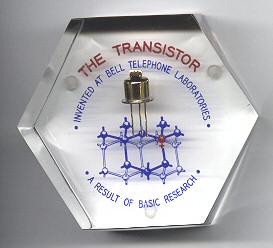
Bell Labs “The Transistor” Paperweight

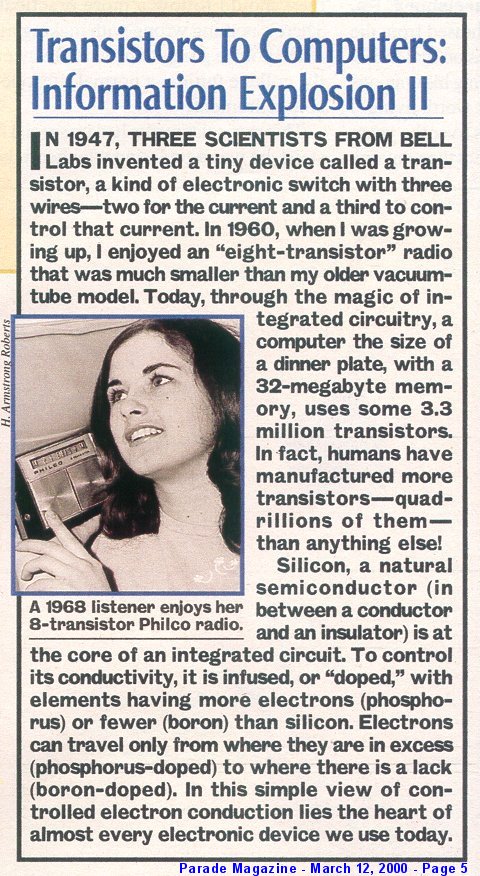

Click on image above to see entire “First Day Cover” envelope

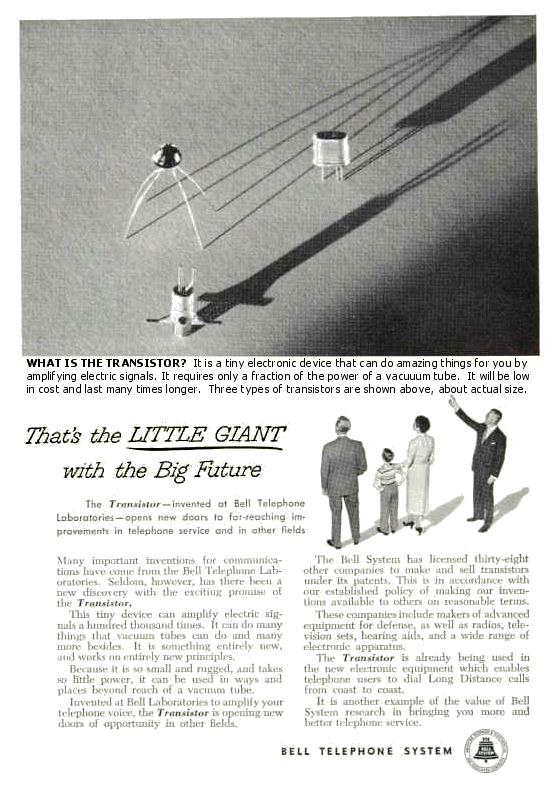

Could the transistor be the result of “reverse engineering” of the electronic remains of the UFO that landed in Roswell in 1947?

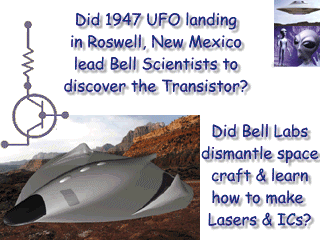



Reliable, secure high-speed internet
With CenturyLink Simply Unlimited Internet, you can choose from a wide range of available speeds that fit your online needs. Plus, you can connect several devices with super-fast in-home WiFi.
Order Now


